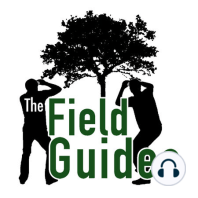59 min listen
Ep. 55 - Bill and Steve Go to Hell(benders)
FromThe Field Guides
ratings:
Length:
68 minutes
Released:
Jan 31, 2022
Format:
Podcast episode
Description
What’s dark and slimy and over two feet long? It’s an Eastern Hellbender! This aquatic giant salamander, endemic to the eastern and central US, is the largest amphibian in North America, often weighing in at over 4 lbs.! The hellbender (Cryptobranchus alleganiensis) is, not unlike Steve, secretive and slimy but also fascinating. Join the guys for one hell of an episode learning about this rare and disappearing denizen of fast-moving streams. This episode was recorded on January 22, 2022 at Chestnut Ridge County Park in Orchard Park, NY.Episode NotesBill said that the Kinzua Bridge was about 300 feet long, but he was mistaken. The bridge was about 300 feet high. The length was 2,053 feet. When Bill was talking about the white tips on hellbender toes, he mistakenly said that hellbenders have “fingers”. D’oh! Bill understand that salamanders don’t have toes, but he wants everyone to know he was using the term in a cutesy way.Steve mentioned his friend Zachary Cava and Zack’s research into hellbenders. Bill was able to track down Zack’s study! Full citation below under “Works Cited”.Around the 20:50 mark, Steve wonders if there is an ecological concept or law stating that larger species tend to go extinct more quickly than small species. After recording, Bill did some searching but could not find any specific law. Anyone out there that knows of one? Please get in touch with us!Bill gave a quick and somewhat vague definition of siltation. Here’s a more complete definition: Siltation refers both to the increased concentration of suspended sediments and to the increased accumulation of fine sediments on [waterway] bottoms where they are undesirable. Source: https://en.wikipedia.org/wiki/SiltationUseful LinksCheck out Life Among the Milkweed, the new book from friend-of-the-podcast Melissa Borowicz BetrusVisit Kinzua Bridge State Park and Sky Walk in PennsylvaniaEllen Paquette’s WeeBeasties Etsy Shop (Paquette is the artist who created the plush hellbender Bill mentioned in this episode) Stuff You Should Know’s excellent episode on zoos: Are Zoos Good or Bad For Animals?SponsorsGumleaf Boots, USA (free shipping for patrons)Thank you to Always Wandering Art (Website and Etsy Shop) for providing the artwork for many of our previous episodes!Support Us Support us on Patreon!Check out the Field Guides merch at our Teespring store. It’s really a great deal: you get to pay us to turn your body into a billboard for the podcast! Works CitedBodinof, C.M., Briggler, J.T., Junge, R.E., Beringer, J., Wanner, M.D., Schuette, C.D., Ettling, J., Gitzen, R.A. and Millspaugh, J.J., 2012. Postrelease movements of captive-reared Ozark hellbenders (Cryptobranchus alleganiensis bishopi). Herpetologica, 68(2), pp.160-173.Cava, Z.A., McMillan, A.M., Pennuto, C.M. and Warren, R.J., 2018. Hellbender prey preference is superseded by native and nonnative prey behavior. Journal of Herpetology, 52(2), pp.162-170.Crowhurst, R.S., Faries, K.M., Collantes, J. et al. Genetic relationships of hellbenders in the Ozark highlands of Missouri and conservation implications for the Ozark subspecies (Cryptobranchus alleganiensis bishopi). Conserv Genet 12, 637–646 (2011). https://doi.org/10.1007/s10592-010-0170-0Foster, R.L., 2018. Lessons From the Past: A Historical Approach to Conservation of the Eastern Hellbender Salamander (Cryptobranchus alleganiensis) (Doctoral dissertation, State University of New York at Buffalo).Photo Credit"Hellbender" by John Garret is licensed under CC BY NC
Released:
Jan 31, 2022
Format:
Podcast episode
Titles in the series (81)
Ep. 01 - Goldenrod Galls: Bill and Steve explore goldenrod galls by The Field Guides
